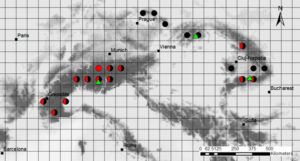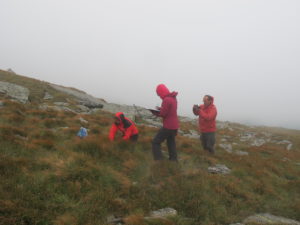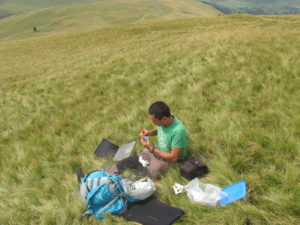During the field season of 2016, the ODYSSEE researchers were involved in a field campaign that aimed to: (i) gather microclimate data recorded by the HOBO loggers installed in 2014 in the sites, (ii) place new data loggers to better represent the range of environmental conditions of alpine meadows by including “thermic alpine” settings, and (iii) record and check vegetation data in the sites.
Information on the dynamics of climate in the ODYSSEE sites consisted in series of recordings at a regular interval (each two hours) of temperature in soil, and light/temperature at canopy level. The data loggers collected now were those installed in the 2014 field campaign across the Alps and Carpathians. The eastern side of the range comprising the Carpathians and Sudetes was visited in 2016 by a team of both French and Romanian ODYSSEE researchers, while the Alps were revisited by the French team.

Fig. 1 – The ODYSSEE sites visited in 2016. The main task of the field campaign was to download the temperature and light data recorded by loggers since 2014, and to replace the devices’ batteries. (Red) – communities dominated by Carex curvula; (black) – communities dominated by Nardus stricta; (green) – newly installed sites (2016) that are meant to capture more of the ecological range of alpine grasslands.
In order to include much contrasting micro-topographic conditions, several additional climate data loggers were installed in places chosen by expert knowledge. The new points will help for a better definition of the bioclimatic envelope of alpine grasslands. Preliminary data have shown the key role of both snow cover regime and thermal stress for the distribution of the grasslands dominated by Carex curvula. Therefore, in addition to the more favorable topographic conditions (such as those sampled in 2014 and 2015), we now targeted limiting environments such as the “thermic alpine” sites on windy crests in the Alps and Carpathians (Choler et Michalet 2002, Choler et al. 2004, Choler 2005). Here, besides Carex curvula, more stress-tolerant species such as Juncus trifidus and Oreochloa disticha occur frequently with high abundances. In the Western Carpathians (Kráľova Hoľa in Nízke Tatry, Slovakia – Fig. 2 left) we installed a plot in a windy crest dominated by Juncus trifidus, having in mind that Carex curvula is absent in this particular region of the Carpathians.


Fig. 2 – Photos taken during the field campaign. Left – installing temperature loggers in the Nízke Tatry, (Slovakia); right – downloading data from a temperature logger at Știol, Rodna Mountains (Romania)
We have succeeded to recover most of the data loggers (Fig. 2 – right). With few exceptions, the loggers were destroyed by animal or human activity, such as in the Nardus stricta site of the Apuseni Mountains in the Romanian Carpathians. Other data loggers stopped due to unexplained reasons. However, such situations were expected since these small devices were left in highly exposed grasslands for a relatively long period. In cases where loggers were lost, they had replicates that kept recording data at site level. We remind that for each site we previously installed two temperature loggers in the soil (Hobo UA-001-64) and 1-2 at the canopy level for temperature and light (Hobo UA-002-64).
Since ODYSSEE focused on long-term monitoring of the mountain grasslands, we now replaced the batteries of the loggers, while nearly keeping their initial position in the sites.
The data downloaded from the loggers has already been compiled to calculate microclimatic parameters such as the snow cover duration, growing degree days, intensity of winter frosts etc. These represent key environmental variables that will be used to better understand the distribution and functioning of the mountain grasslands.
In addition to the work carried out on climate loggers, during the field campaign of 2016 we recorded the abundance of vascular plants in the additionally set up sites (i.e. phytosociological releves). We also checked the species composition in some of the sites revisited in the Alps.